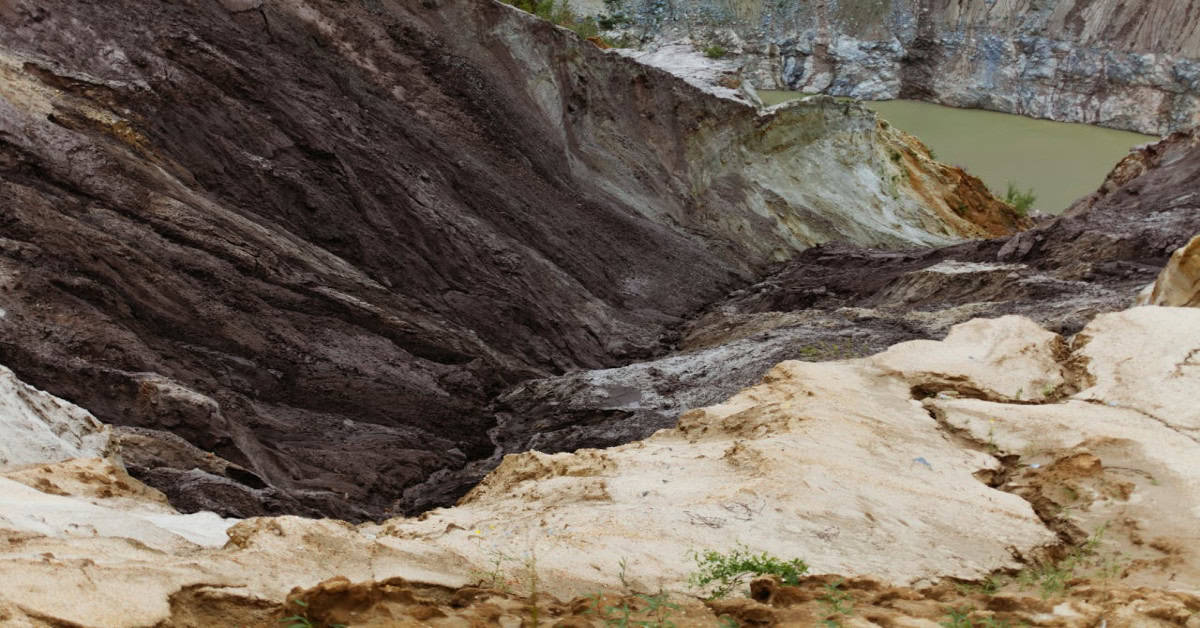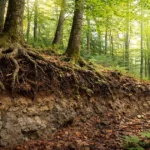Soil erosion is the process where the top layer of soil gets worn away. This can happen naturally or because of human activities. Understanding the common causes of soil erosion and its impacts is crucial.
Soil erosion affects farming, the environment, and even our daily lives. When the soil is lost, it takes away nutrients, making the land less fertile.
For students studying geography, answering What are the causes of soil erosion helps them grasp its importance. Besides, it teaches them how erosion affects not just land but entire ecosystems. This knowledge is vital for future generations to manage land use better.
In this blog, we will explore the common causes of soil erosion and its impacts. We’ll also discuss the natural and human-induced reasons for soil loss and its effects.
What is Soil Erosion?
Soil erosion is the process where the top layer of soil is removed by natural forces or human activities. This layer is important because it contains nutrients essential for plants. Wind, rain, and water runoff are natural causes of erosion. They gradually wear away the soil over time.
Human activities, such as deforestation and farming, can make erosion worse by disturbing the soil. When we learn what are the causes of soil erosion, we can understand why protecting the soil is essential. In both natural and human-induced cases, erosion reduces the quality of land.
Erosion can make it harder for plants to grow and lead to other environmental problems. Understanding erosion is key to preventing soil loss and protecting the environment.
Why is Understanding Soil Erosion Important?
Understanding soil erosion is important for many reasons. First, it helps maintain agricultural productivity. When soil is lost, crops don’t get the nutrients they need. This reduces the amount of food we can grow. Furthermore, erosion affects the environment by damaging ecosystems and polluting water bodies.
Keeping the soil in place helps preserve nature and maintain balance. For students, learning about soil erosion is important because it gives them the tools to prevent environmental damage in the future. By knowing the causes, they can think of ways to stop it.
In this way, sustainable land use becomes a reality. Besides, preventing soil erosion helps reduce the risk of desertification, floods, and other natural disasters. This knowledge is key to building a sustainable and safe environment for all.
Common Causes of Soil Erosion
Soil erosion happens when the upper layer of soil is worn away. Natural forces like wind, rain, glaciers, and gravity are common causes. However, human activities like deforestation and poor farming practices make the problem worse.
Erosion can occur gradually or rapidly, depending on the forces involved. The result is often a loss of fertile soil, which harms plant growth and disrupts ecosystems. Below, we will explore both natural and human-induced causes of soil erosion in detail.
Also Read: An Informational Guide to Land Pollution
Natural Causes of Soil Erosion
Natural processes that causes soil erosion are:
Rainfall and Water Runoff
Heavy rainfall is one of the main causes of soil erosion. When rain falls too quickly for the soil to absorb it, water runoff occurs. This runoff carries the topsoil away, especially in areas with steep slopes. The faster the water flows, the more soil it can displace.
This is common in regions with poor vegetation cover, as there is nothing to slow the water down. Over time, continuous heavy rainfall can cause significant soil loss. For example, monsoon rains in tropical regions often lead to severe erosion.
Therefore, managing water flow through terracing or planting cover crops is essential to reduce erosion caused by rainfall.
Wind Erosion
Wind erosion is most common in dry and semi-arid areas. Strong winds can lift loose soil particles and transport them over long distances. When there is little vegetation to hold the soil in place, the wind can easily blow it away. This type of erosion is particularly harmful to farmland.
The top layer, which is rich in nutrients, is often the first to go. Besides, wind erosion can create dust storms, which affect air quality and reduce visibility. Therefore, planting windbreaks, such as trees or bushes, is an effective way to reduce soil loss due to wind.
Glacial Movement
Glacial erosion occurs in cold regions where glaciers slowly move across the land. As glaciers advance or retreat, they carry large amounts of soil and rock with them. This process grinds the soil beneath the glacier, breaking it down into smaller particles.
As the glacier melts, the water further erodes the landscape, carrying the soil away. Over time, glacial erosion can dramatically change the shape of the land.
For example, valleys formed by glaciers are often U-shaped due to the extensive soil displacement. In this way, glaciers act as a powerful natural force of erosion in cold environments.
Gravity and Landslides
Gravity is a key factor in soil erosion, especially on steep slopes. Landslides occur when soil, rocks, and debris slide down a hill or mountain. This can happen suddenly, often after heavy rain or an earthquake loosens the soil. Landslides quickly displace large amounts of soil, leaving the land bare and unstable.
Besides, landslides can cause long-term damage by making the soil more prone to future erosion. When gravity pulls soil downhill, it removes the protective layer that helps plants grow, making the land less fertile.
Therefore, stabilizing slopes through terracing or retaining walls is crucial to prevent gravity-induced erosion.
Human-Induced Causes of Soil Erosion
Human activities also cause soil erosion these activities are:
Deforestation
Deforestation is a major cause of soil erosion. Trees and plants play a vital role in holding the soil together with their roots. When trees are cut down, the soil loses this support and becomes loose. Rain and wind can then easily wash or blow the soil away.
Besides, deforested areas often have less organic matter to absorb water, increasing runoff and erosion. In many parts of the world, large-scale deforestation for agriculture or logging has led to severe soil degradation.
For example, in tropical rainforests, deforestation has caused the land to lose its fertility quickly. Replanting trees and reducing deforestation are key steps to preventing erosion.
Overgrazing
Overgrazing happens when livestock eat too much vegetation, leaving the soil exposed. In areas with too many animals, plants don’t have a chance to regrow. Without plants to protect it, the soil becomes vulnerable to erosion by wind and water.
Over time, overgrazing can turn fertile land into barren deserts, a process known as desertification. This is a serious problem in arid regions where vegetation is already scarce.
Farmers and herders must manage grazing patterns to ensure the land can recover. Rotational grazing, where animals move between fields, is one method to prevent soil loss due to overgrazing.
Agricultural Practices
Certain farming methods can increase the risk of soil erosion. For example, monocropping (growing the same crop year after year) depletes the soil’s nutrients and weakens its structure. Similarly, plowing fields disrupts the soil layers, making it easier for wind and water to carry it away.
In addition, over-irrigation can lead to runoff, which washes the soil away. Sustainable agricultural practices, such as crop rotation and reduced tillage, help maintain soil health and structure.
By diversifying crops and using less disruptive farming methods, farmers can protect the soil from erosion and improve its long-term productivity.
Urbanization and Construction
Urbanization and construction are human activities that greatly disturb the soil. As cities expand, forests and grasslands are cleared to make way for roads, buildings, and other infrastructure. This process removes the vegetation that protects the soil, leaving it exposed to erosion.
In addition, construction often involves digging and moving large amounts of soil, further weakening its structure. Rainfall on exposed construction sites can cause rapid soil loss through runoff.
Moreover, urban areas have more paved surfaces, which prevent water from soaking into the ground, increasing erosion risks. Sustainable urban planning, such as green spaces and better drainage systems, can help reduce soil erosion caused by construction.
Impacts of Soil Erosion
Soil erosion has serious effects on the environment, economy, and society. When topsoil is lost, land becomes less productive, and ecosystems are disrupted. The impacts are far-reaching, affecting not only farmers and communities but also water bodies and biodiversity.
Below, we discuss the various environmental, economic, and social impacts of soil erosion in detail.
Environmental Impacts
Environmental impacts of soil erosion are:
Loss of Fertile Topsoil
One of the most immediate effects of soil erosion is the loss of fertile topsoil. This upper layer of soil contains essential nutrients that support plant growth. Without it, plants struggle to survive, and agricultural productivity declines. Farmers face lower crop yields, and the land becomes less fertile over time.
As the soil structure weakens, it can no longer retain water and nutrients effectively, further reducing its ability to support vegetation. This creates a vicious cycle where more erosion occurs, leading to even greater soil degradation.
Sedimentation in Water Bodies
When soil erodes, it often ends up in nearby rivers, lakes, and streams. This process is known as sedimentation. Sediment can clog waterways, reducing their depth and flow. As a result, aquatic habitats are disrupted, affecting fish and other species.
Furthermore, sediment can carry harmful chemicals or pesticides from agricultural lands into water bodies, causing water pollution. This not only affects wildlife but also the quality of water for human consumption.
Desertification
In dry regions, soil erosion can accelerate the process of desertification. As the topsoil is lost, the land becomes barren and less able to support vegetation. Over time, this leads to the spread of deserts.
Desertification reduces the availability of productive land, making it harder for communities to grow food and survive in these regions. It also contributes to climate change, as deserts reflect more heat into the atmosphere.
Economic and Social Impacts
Economic impacts of soil erosion include:
Decreased Agricultural Productivity
Soil erosion has a direct impact on agricultural productivity. As the topsoil is lost, the land becomes less fertile, and crop yields decline. Farmers often lose their most productive land first, which can severely affect their income.
In areas where agriculture is the main source of livelihood, this can lead to food shortages and increased poverty. Furthermore, soil erosion makes it more difficult for farmers to invest in sustainable farming methods, as they must deal with the immediate loss of productivity.
Therefore, preventing soil erosion is not just an environmental issue but also an economic one.
Increased Costs for Land Rehabilitation
Rehabilitating eroded land can be a costly process for both governments and farmers. It often involves replanting vegetation, improving soil health, and building structures to control water flow. These efforts require significant financial resources and time.
For small-scale farmers, the costs can be overwhelming, forcing them to abandon their land. Governments may also face high expenses in rehabilitating large areas of degraded land to maintain food production and environmental stability.
Impact on Communities
Soil erosion can have devastating effects on communities that rely on agriculture for their livelihoods. As land becomes less productive, people may be forced to migrate to other areas in search of better opportunities. This displacement can lead to social and economic instability.
Furthermore, the loss of agricultural productivity can cause food shortages, affecting the health and well-being of entire communities. Addressing soil erosion is crucial for ensuring the survival and prosperity of these vulnerable populations.
How to Prevent Soil Erosion?
There are several effective methods to prevent soil erosion, which focus on stabilizing the soil, reducing water runoff, and preserving land productivity. These techniques are vital for sustainable land management and maintaining healthy ecosystems. Below are some key methods to combat soil erosion:
Afforestation and Reforestation
Planting trees through afforestation and reforestation helps to stabilize the soil. Trees act as windbreakers and their roots bind the soil, preventing it from being washed or blown away.
In addition, trees reduce the impact of rainfall on the soil, minimizing surface runoff. Therefore, increasing forest cover is a crucial strategy in areas prone to erosion.
Terracing and Contour Plowing
Terracing and contour plowing are common methods used by farmers in hilly regions to control soil erosion. Terracing creates step-like structures on slopes, which slow down water flow and allow more time for water absorption.
Similarly, contour plowing involves plowing along the natural contours of the land, reducing water runoff and minimizing soil loss. Both methods are effective in preventing erosion in sloped areas.
Use of Cover Crops
Cover crops, like grasses and legumes, are grown to protect the soil when main crops are not in season. These plants help hold the soil in place and reduce the impact of rain on bare land.
Besides, cover crops improve soil structure by adding organic matter, making the soil more resistant to erosion. This method is particularly useful in agriculture for long-term land health.
Sustainable Grazing Practices
Overgrazing by livestock can strip land of vegetation, leading to increased soil erosion. Sustainable grazing practices, such as rotational grazing, can help prevent this.
By rotating livestock between different pastures, the land is given time to recover, and its vegetation can regrow. This method ensures that the soil remains covered with grass, reducing the risk of erosion.
Conclusion
Soil erosion is caused by both natural forces and human activities. Its impacts are severe, ranging from loss of fertile topsoil to economic challenges for farmers. However, several prevention methods, such as afforestation, terracing, the use of cover crops, and sustainable grazing, can reduce erosion significantly.
understanding the causes of soil erosion and its preventive methods is crucial. It ensures that we maintain healthy ecosystems, promote agricultural productivity, and preserve our environment for future generations.






